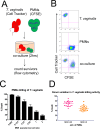Neutrophils kill the parasite Trichomonas vaginalis using trogocytosis
- PMID: 29408891
- PMCID: PMC5815619
- DOI: 10.1371/journal.pbio.2003885
Neutrophils kill the parasite Trichomonas vaginalis using trogocytosis
Abstract
T. vaginalis, a human-infective parasite, causes the most common nonviral sexually transmitted infection (STI) worldwide and contributes to adverse inflammatory disorders. The immune response to T. vaginalis is poorly understood. Neutrophils (polymorphonuclear cells [PMNs]) are the major immune cell present at the T. vaginalis-host interface and are thought to clear T. vaginalis. However, the mechanism of PMN clearance of T. vaginalis has not been characterized. We demonstrate that human PMNs rapidly kill T. vaginalis in a dose-dependent, contact-dependent, and neutrophil extracellular trap (NET)-independent manner. In contrast to phagocytosis, we observed that PMN killing of T. vaginalis involves taking "bites" of T. vaginalis prior to parasite death, using trogocytosis to achieve pathogen killing. Both trogocytosis and parasite killing are dependent on the presence of PMN serine proteases and human serum factors. Our analyses provide the first demonstration, to our knowledge, of a mammalian phagocyte using trogocytosis for pathogen clearance and reveal a novel mechanism used by PMNs to kill a large, highly motile target.
Conflict of interest statement
The authors have declared that no competing interests exist.
Figures






Similar articles
-
Polymorphonuclear leukocytes (PMNs) use different, strain-dependent mechanisms to kill the parasite Trichomonas vaginalis.mBio. 2025 Aug 13;16(8):e0368024. doi: 10.1128/mbio.03680-24. Epub 2025 Jun 26. mBio. 2025. PMID: 40569066 Free PMC article.
-
Neutrophil interactions with the sexually transmitted parasite Trichomonas vaginalis: implications for immunity and pathogenesis.Open Biol. 2020 Sep;10(9):200192. doi: 10.1098/rsob.200192. Epub 2020 Sep 2. Open Biol. 2020. PMID: 32873151 Free PMC article. Review.
-
Vaginal neutrophils eliminate sperm by trogocytosis.Hum Reprod. 2020 Nov 1;35(11):2567-2578. doi: 10.1093/humrep/deaa198. Hum Reprod. 2020. PMID: 33011783
-
Complement receptor 3 is required for maximum in vitro trogocytic killing of the parasite Trichomonas vaginalis by human neutrophil-like cells.Parasite Immunol. 2024 Feb;46(2):e13025. doi: 10.1111/pim.13025. Parasite Immunol. 2024. PMID: 38372623 Free PMC article.
-
Trichomonas vaginalis: Pathogenesis, Symbiont Interactions, and Host Cell Immune Responses.Trends Parasitol. 2018 Aug;34(8):683-693. doi: 10.1016/j.pt.2018.05.006. Epub 2018 Jun 29. Trends Parasitol. 2018. PMID: 30056833 Free PMC article. Review.
Cited by
-
Gnawing Between Cells and Cells in the Immune System: Friend or Foe? A Review of Trogocytosis.Front Immunol. 2022 Feb 3;13:791006. doi: 10.3389/fimmu.2022.791006. eCollection 2022. Front Immunol. 2022. PMID: 35185886 Free PMC article. Review.
-
Using two phases of the CD4 T cell response to blood-stage murine malaria to understand regulation of systemic immunity and placental pathology in Plasmodium falciparum infection.Immunol Rev. 2020 Jan;293(1):88-114. doi: 10.1111/imr.12835. Immunol Rev. 2020. PMID: 31903675 Free PMC article. Review.
-
Neutrophils versus Protozoan Parasites: Plasmodium, Trichomonas, Leishmania, Trypanosoma, and Entameoba.Microorganisms. 2024 Apr 19;12(4):827. doi: 10.3390/microorganisms12040827. Microorganisms. 2024. PMID: 38674770 Free PMC article. Review.
-
The Biological Significance of Trogocytosis.Results Probl Cell Differ. 2024;73:87-129. doi: 10.1007/978-3-031-62036-2_5. Results Probl Cell Differ. 2024. PMID: 39242376 Free PMC article.
-
Neutrophil extracellular traps induced by Haemonchus contortus excretory-secretory proteins varies among goats, gerbils, and mice.Parasit Vectors. 2025 Jul 28;18(1):304. doi: 10.1186/s13071-025-06956-z. Parasit Vectors. 2025. PMID: 40721816 Free PMC article.
References
-
- Schwebke JR, Burgess D (2004) Trichomoniasis. Clin Microbiol Rev 17: 794–803, table of contents. doi: 10.1128/CMR.17.4.794-803.2004 - DOI - PMC - PubMed
-
- Carlton JM, Hirt RP, Silva JC, Delcher AL, Schatz M, et al. (2007) Draft genome sequence of the sexually transmitted pathogen Trichomonas vaginalis. Science 315: 207–212. doi: 10.1126/science.1132894 - DOI - PMC - PubMed
-
- Hirt RP, Sherrard J (2015) Trichomonas vaginalis origins, molecular pathobiology and clinical considerations. Curr Opin Infect Dis 28: 72–79. doi: 10.1097/QCO.0000000000000128 - DOI - PubMed
-
- Kissinger P (2015) Trichomonas vaginalis: a review of epidemiologic, clinical and treatment issues. BMC Infect Dis 15: 307 doi: 10.1186/s12879-015-1055-0 - DOI - PMC - PubMed
-
- Secor WE, Meites E, Starr MC, Workowski KA (2014) Neglected parasitic infections in the United States: trichomoniasis. Am J Trop Med Hyg 90: 800–804. doi: 10.4269/ajtmh.13-0723 - DOI - PMC - PubMed
MeSH terms
Substances
Grants and funding
LinkOut - more resources
Full Text Sources
Other Literature Sources

